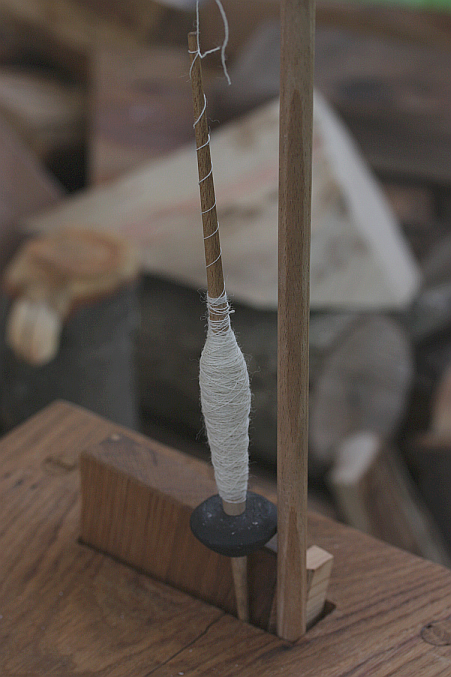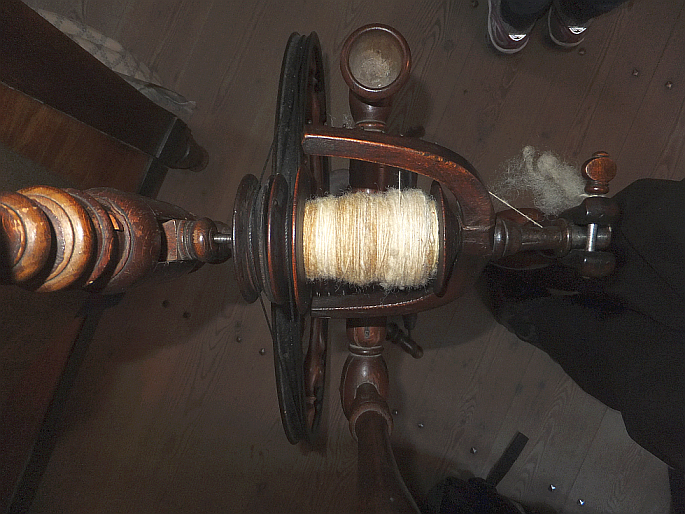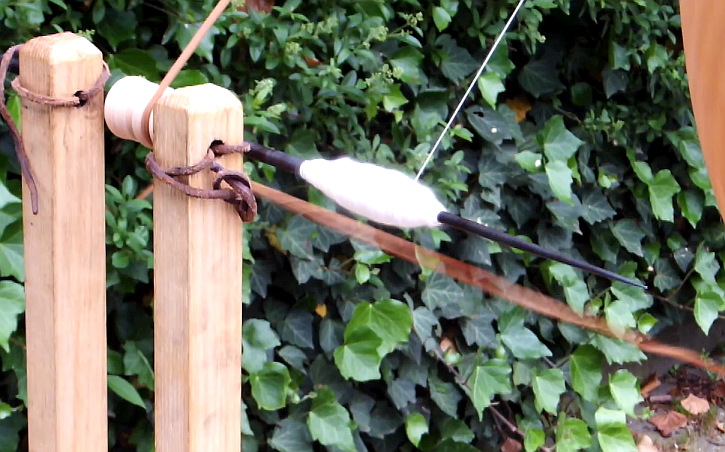One question keeps popping up again and again when spinning is demonstrated or discussed - the Sleeping Beauty question. What did Sleeping Beauty prick her finger on? As answers, you can get the wildest speculations.
Was it a hand spindle?
Hand spindles consist of a spindle stick, usually made from wood, and a spindle whorl. The ends of the spindle stick taper out, becoming ever more narrow. This is necessary for a smooth turning of the spindle, as the thread fixed to the top is closer to the rotational axis, resulting in less wobbling. It also means the spindle can be put into motion easier and faster, as it is easier to twirl a thin stick between the fingers than a thick one. The taper at the lower end allows to fix whorls with different inner hole diameters to the stick.

For both purposes, and thus for both ends, a really pointy tip is not necessary. While it would technically be possible to carve wood into a pointy tip, making this sharp enough to be able to prick skin with it does constitute a challenge. And why would anyone have wanted to do this, anyways? For spinning, a narrow end of 2-3 mm in diameter is perfectly fine. For reducing spindle wobble, it is more important to have a long taper on the top and thus a slender upper end over several centimetres. Any more pointiness, up to the point of finger-pricking shaprness, would mean to purposefully create a risk of injury without any benefit to the working process - a little as if you would consider placing pointy screws into the handle of a shovel, or fixing a needle into the handle of a knife.
Was it a spinning wheel with flyer?
Flyer spinning wheels don't sport a spindle anymore; instead, they have a combination of a bobbin and a flyer. Both are set into rotation with help of a belt and the flywheel. As there is no spindle on this wheel, it's impossible to prick anything on it. The flyer spinning wheel is right out.

So what do we have left?
Was it a Great Wheel?
On the Great Wheel, a spindle is still part of the construction - and typically, it is not made from wood, but from metal. This spindle is horizontal and set into rotation through a belt and a large, hand-driven flywheel. As the spindle turns, the thread is lifted up by the spindle tip, then falls off the tip; this gives twist to the thread. Because of this lift-up-fall-off sequence, it is helpful to have a fine spindle tip, reducing jerks on the thread. The spindle tip thus is significantly thinner than that of a hand-spindle.

However, even here it is not necessary to have a needle-like pointiness for smooth spinning. On my reconstruction, the tip of the spindle is about as pointy as the tine of a normal pastry fork. Thus if you are looking to hurt yourself on a historical spinning tool, the Great Wheel would be your best choice, but it still requires a good amount of motivation, momentum and clumsiness to actually draw blood.
So what sent the Sleeping Beauty to sleep, then?
In a story by the Italian author Basile, printed 1636 in the "Pentamerone", the princess is spinning flax. While she is at work, a splinter of wood finds its way under her fingernail, and this does the job (see Gilbert, Ruth. "Where's the bit the Sleeping Beauty pricked her finger on?" Journal for Weavers, Spinners and Dyers 179 (1996): 24). Flax or hemp that has not been processed to a high quality can still sport individual bits of wood that might be more or less pointy - these are from the woody parts of the plant.
Whether a splinter from flax stems or a good helping of clumsiness and a Great Wheel's spindle are to blame for the hundred years of sleep is impossible to tell; after all, it's a story, too, and we might assume some artistic licence as well. However, the hand-spindle and the more modern flyer wheel cannot have been the culprits.
















